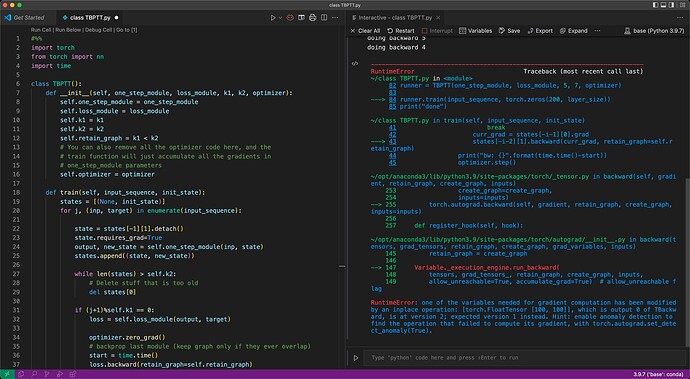The following code works for some new pytorch versions. The in-place ops are now performed on the ‘data’ field of the parameters.
class TBPTT():
def __init__(self, one_step_module, loss_module, k1, k2, optimizer):
self.one_step_module = one_step_module
self.loss_module = loss_module
self.k1 = k1
self.k2 = k2
self.retain_graph = k1 < k2
# You can also remove all the optimizer code here, and the
# train function will just accumulate all the gradients in
# one_step_module parameters
self.optimizer = optimizer
def train(self, input_sequence, init_state):
states = [(None, init_state)]
for j, (inp, target) in enumerate(input_sequence):
state = states[-1][1].detach()
state.requires_grad=True
output, new_state = self.one_step_module(inp, state)
states.append((state, new_state))
while len(states) > self.k2:
# Delete stuff that is too old
del states[0]
if (j+1)%self.k1 == 0:
loss = self.loss_module(output, target)
optimizer.zero_grad()
# backprop last module (keep graph only if they ever overlap)
start = time.time()
loss.backward(retain_graph=self.retain_graph)
for i in range(self.k2-1):
# if we get all the way back to the "init_state", stop
if states[-i-2][0] is None:
break
curr_grad = states[-i-1][0].grad
states[-i-2][1].backward(curr_grad, retain_graph=self.retain_graph)
print("bw: {}".format(time.time()-start))
optimizer.step()
seq_len = 20
layer_size = 50
idx = 0
class MyMod(nn.Module):
def __init__(self):
super(MyMod, self).__init__()
self.lin = nn.Linear(2*layer_size, 2*layer_size)
self.param_data = []
def trans_grad(source, other):
def trans_fn(grad):
other.grad = grad + 0 if source.grad is None else source.grad
return trans_fn
for p in self.parameters():
d = p.data.requires_grad_()
self.param_data.append(d)
p.register_hook(trans_grad(p, d))
def forward(self, inp, state):
global idx
full_out = self.lin(torch.cat([inp, state], 1))
# out, new_state = full_out.chunk(2, dim=1)
out = full_out.narrow(1, 0, layer_size)
new_state = full_out.narrow(1, layer_size, layer_size)
def get_pr(idx_val):
def pr(*args):
print("doing backward {}".format(idx_val))
return pr
new_state.register_hook(get_pr(idx))
out.register_hook(get_pr(idx))
print("doing fw {}".format(idx))
idx += 1
return out, new_state
one_step_module = MyMod()
loss_module = nn.MSELoss()
input_sequence = [(torch.rand(200, layer_size), torch.rand(200, layer_size))] * seq_len
optimizer = torch.optim.SGD(one_step_module.param_data, lr=1e-3)
runner = TBPTT(one_step_module, loss_module, 5, 7, optimizer)
runner.train(input_sequence, torch.zeros(200, layer_size))
print("done")



